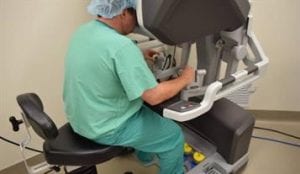Article previously published in the Log Cabin Democrat.
Baptist Health Medical Center-Conway recently acquired cutting-edge technology that is reshaping the way doctors perform surgery and drastically reducing recovery time for patients. Using four arms that connect into ports with the surgeon sitting at his own machine — like a video game essentially — the da Vanci XI Surgical System provides doctors with 3D visualization, great magnification in the body to perform precise and delicate maneuvers and ability to see small structural issues. It is vital for patients to have the best outcome possible while decreasing the risk of possible surgery complications, hospital stay and recovery time. The hospital purchased the robot for $2.5 million, the surgery bed for better movement at around $100,000 and other pieces of equipment in September, making the Conway location the first in the state to have the complete system. The da Vinci Xi is used multiple times a week by Urologist Dr. Jeff Marotte and Dr. Joseph Ivy in gynecologic oncology, among others. One of the reasons the robot is so revolutionary is because of the decreased amount of time it takes to perform the surgery in the first place. By 1 p.m. Dec. 7, Ivy had already completed seven surgeries that day. “[That’s] kind of a testament to how efficient the crew is and the technology — how it’s advanced and how it’s able to do very difficult surgeries that used to take twice, three times as long and recovery was five, six, seven times as long and allows us to do everything in concise, more precise manners,” he said.
That aspect, Ivy said, directly correlates to how technology has evolved in the medical field through the years. Doctors once only performed open surgery which came with more risks, longer recovery time for patients and morbid scarring. Ivy has been practicing for more 10 years, and about halfway through his fellowship, the robotic systems became more prominent. “It took a little while for even our community to believe it because we always think we’re a bunch of open surgeons,” he said. “We used to be. We always thought open surgery was the only way to do it.” Ivy said it took multiple studies to prove to the surgeons that doing a procedure laparoscopically or robotically — minimally invasive surgeries — produced just as good outcomes but also incredibly altered recovery periods. Ivy said, the robot has found it’s place — it’s sweet spot—used in surgeries in small areas requiring precise maneuvers. “The optics are 1,000s times better,” he said. “You can visualize in multiple difference wavelengths and so I can see vessels, I can see [the] ureter, I can see lymph nodes that you can’t see laparoscopically, so you’re way more precise with your staging.” Ivy said his favorite part about the da Vinci XI is the overall outcomes from survival rate to short-term recovery with less pain and suffering, to shorter hospital stays and lower risk of infection and bleeding. “Everything that you could ever think about surgery is minimized with the robot so being able to take a complex situation like a malignancy and minimize all risks is absolutely the reason the robot should be in existence,” he said. What he’s found, Ivy said, is that most people aren’t taking advantage of the technology simply because they aren’t aware of it’s existence, let alone how it performs. “It’s really sad that somebody has such technology that could really, really improve their outcome to such an advantage and nobody knows about it,” he said.
“It’s kind of bizarre that it’s like that.” Especially the “latest, greatest, absolute most technologically advanced one” Baptist currently possesses. Dr. Marotte, who has been in urology for 12 years, said he hardly does open surgeries anymore and when it comes down to it, performs close to 95 percent of procedures with the hospital’s robot. “There are things I can see in the body that maybe [are] so minute and so delicate that I can appreciate the anatomy and just really do a really beautiful surgery whereas before there was too much blood loss and I couldn’t see clearly,” he said. Marotte said using the robot allows him to do more physically than he could with his own hands — essentially like laparoscopic surgery on steroids — while sitting comfortably at a machine, not over a patient on foot, which could actually extend his career. “It’s a lot of fun,” he said. “Obviously, I’m highly focused during surgery and that’s all I’m thinking about during surgery but what’s the most [rewarding] is seeing the patient after surgery, one month later, their life is changed, hopefully they’re cured or much improved from where they were before and they’re back to work and back to their daily life.” Terri Pendergraft, the director of Perioperative Services and Cath Lab/ IVR, said that is essentially the point of why they do what they do — the good of the patient. The surgery, which doesn’t cost more for the patient and is covered by insurance, was worth every penny, she said. “Our whole goal is to give a patient back their life, their mobility, to do the things they want to do,” Pendergraft said. “We want to give them the best outcome possible and the da Vinci [XI] allows us to do that very technical surgery. That’s something that we strive to give and that’s what gives us the edge.” According to a news release, the da Vinci Surgical System first became available in 2000 and since that time, more than 3,000,000 procedures have been completed worldwide. Currently, the system is used for general, urology, gynecology and cardiothoracic surgeries.


